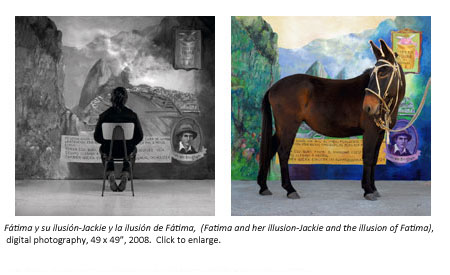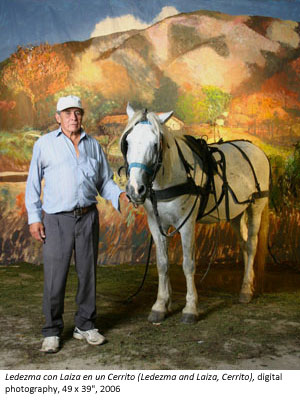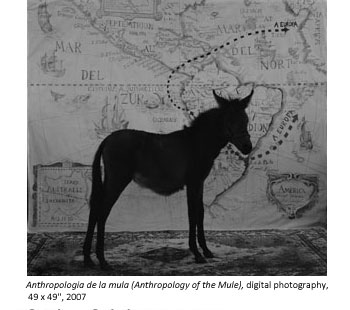Fall 2012: 'Beasts of Burden,' Drawings, Photographs and Videos from Argentina
by Kathleen McCoy |
 Gallery Dates:
Gallery Dates:
Oct. 15-Nov. 9, 2012
Kimura Art Gallery
Fine Arts Buiilding 2nd Floor
Public Screening Times for Videos
Oct. 17, 18, 22, 24, 7:15 p.m.
Fine Arts Building, Room 117
- Primavera (Spring), 2004, 5 minutes
- Elevación de Ushuaia (Elevation of Ushuaia), Performance, 2009, 5 minutes
- Bomarzo, 2010, 4 minutes
- Entrevista a Fátima (Interview with Fatima), 2010, 4:52 minutes
- If Ye Loves Me, 2010, 3 minutes
- Paisajes del alma (Landscapes of the Soul), 2011, 4:03 minutes
This exhibition of the internationally acclaimed Argentinian artist Adriana Bustos's
artwork is an extraordinary body of work. She is a socially engaged artist who bridges
the world of art and politics. The body of work in this exhibition focuses on Argentinian
class issues and drug trafficking on a global scale. Her work combines politics and
art in montage like narrative formats using graphite on canvas, digital photography
and video to explore the global problem of drugs, the incarceration of women who are
used as "human mules" to transport drugs and a class of poor workers known as cartoneros.
During 2001 Argentina experienced an economic crisis that resulted in the closing of thousands of factories throughout the country. Today over 30 percent of the country is below the poverty line and the unemployment rate is one of the reasons for this situation.
Thousands of businesses and factories were closed down and many workers lost their
jobs throughout the country. This resulted in accelerating the disparity between the
upper classes and the working poor. As a result of the lack of employment, groups
of workers organized themselves and took over factories and various businesses.  These radicalized cooperative ventures came together to do what the government was
incapable of providing-jobs. There is one group of poor residents from the outlying
areas of Buenos Aires who roam the city at night to collect and sell recyclable materials
that they salvage from the waste. These waste pickers are known as cartoneros. By rummaging through the waste they pick out the cardboard, paper, metal and glass.
Bustos developed a series of works focused on this class of workers and produced some
beautiful portraits focusing on the horses and the cartoneros as a means of exploring their economic plight. Works such as Ledezma con Laiza en un Cerrito (a portrait of a cartoneros and his horse that pulls the cart), her video Primavera (Spring) which uses a camera placed on the horse's head allowing one to see this nocturnal
world through the eyes of the horse in an abstract manner, and the Los Retratos (Portraits) series of horses are sensitively and vividly portrayed. As she explored the situation
of the wastepickers, she was also engaged in focusing her attention on the problem
of drug trafficking in Argentina.
These radicalized cooperative ventures came together to do what the government was
incapable of providing-jobs. There is one group of poor residents from the outlying
areas of Buenos Aires who roam the city at night to collect and sell recyclable materials
that they salvage from the waste. These waste pickers are known as cartoneros. By rummaging through the waste they pick out the cardboard, paper, metal and glass.
Bustos developed a series of works focused on this class of workers and produced some
beautiful portraits focusing on the horses and the cartoneros as a means of exploring their economic plight. Works such as Ledezma con Laiza en un Cerrito (a portrait of a cartoneros and his horse that pulls the cart), her video Primavera (Spring) which uses a camera placed on the horse's head allowing one to see this nocturnal
world through the eyes of the horse in an abstract manner, and the Los Retratos (Portraits) series of horses are sensitively and vividly portrayed. As she explored the situation
of the wastepickers, she was also engaged in focusing her attention on the problem
of drug trafficking in Argentina.
Her best known work focusing on the drug problem is her ongoing project, The Anthropology of the Mule Project that was initiated in 2007. The metaphor of the mule is used to illustrate the transformation of the mule from its colonial days as a beast of burden in the context of colonial exploitation of mineral resources and other goods and today's reference to "human mules" who are exploited by drug cartels and smuggling rings to transport illegal drugs to other countries. In some of her graphite drawings she illustrates the routes human mules used to transport the drugs (which are swallowed in capsules). My Cocaine Museum, 2008 and RRHH (La Ruta de Herson/The Route of Herson), 2011 typify these large scale scroll drawings. These women drug couriers have dreams of escaping their impoverished circumstances, but most of these dreams are tragically shattered. By using a montage-like set of visual juxtapositions Bustos has the viewer reconstruct various images that are interesting and wide-ranging in their meanings. Yet, one never escapes the message of exploitation and the tragedy of the narco-mules.
As Gustavo Bláquez noted: "Colonial maps, world maps, and trafficking routes mix together with goods like Mariani Wine or pills for dental pain whose container shows a tender and kitschy image of two children gathering the fruits of a generous Nature. A giant bottle and a naked woman meld into a single visual reality to publicize a tonic that "sustains and refreshes the body and brain" while at the same time promising to double productivity without any fatigue. This world of fantasies created in and by goods appears in the Hemingway quote that opens one of the illustrations, "When I dream of my afterlife in heaven, the action always takes place at the Paris Ritz," and its accompanying image.
Amid these dreams of consumption, exhibited through fossilized goods from a primordial pharmaco-pornographic capitalism, the artist introduces the gore world of crime, police, and espionage. Secret weapons hidden under a jacket sleeve, devices for wiretapping telephones, self-defense techniques, criminological science with its positivist research and its fascination with the bodily indications of criminality, portraits, physiognomy and X-rays. Finally, in the lower left quadrant, a prison "built in the panopticon design."
 Her efforts to deal with the plight of women who are incarcerated in Argentinian
jails for drug trafficking is an amazing exposé of the drug trade and its use of women
to function as "human mules." Bustos's Anthropology of the Mule photograph and the accompanying Anthropology of the Mule graphite drawing, and her series of diptychs, two of which are in this exhibition
explore this theme. Leonor y su ilusion-Yolanda y la Ilusion de Leonor (Leonor and her illusion-Yolanda
and the Illusion of Leonor) and Fátima y su ilusión-Jackie y la ilusión de Fátima (Fatima and her illusion-Jackie
and the illusion of Fatima) metaphorically conveys her referencing to beasts of burden-the human mule whose
black and white image has the woman's back facing the viewer, and opposite and next
to it, one has the colored image of the full-bodied mule facing the viewer. She uses
two uniform sized photographs with the same backdrop of Machu Picchu painted in a
naïve folk manner. These backdrops were used as sets in the public squares for tourists
to take home a souvenir photograph. The video, Entrevista a Fátima (Interview with Fatima), explores the crushed dreams of one of these jailed drug couriers by the name of
Fátima (a translation is at the gallery). As an engaged artist in the political sense,
she represents that rare artist who is trying to make the public aware of the plight
of women who have been used in the drug trade for monetary gain by means of art.
Her efforts to deal with the plight of women who are incarcerated in Argentinian
jails for drug trafficking is an amazing exposé of the drug trade and its use of women
to function as "human mules." Bustos's Anthropology of the Mule photograph and the accompanying Anthropology of the Mule graphite drawing, and her series of diptychs, two of which are in this exhibition
explore this theme. Leonor y su ilusion-Yolanda y la Ilusion de Leonor (Leonor and her illusion-Yolanda
and the Illusion of Leonor) and Fátima y su ilusión-Jackie y la ilusión de Fátima (Fatima and her illusion-Jackie
and the illusion of Fatima) metaphorically conveys her referencing to beasts of burden-the human mule whose
black and white image has the woman's back facing the viewer, and opposite and next
to it, one has the colored image of the full-bodied mule facing the viewer. She uses
two uniform sized photographs with the same backdrop of Machu Picchu painted in a
naïve folk manner. These backdrops were used as sets in the public squares for tourists
to take home a souvenir photograph. The video, Entrevista a Fátima (Interview with Fatima), explores the crushed dreams of one of these jailed drug couriers by the name of
Fátima (a translation is at the gallery). As an engaged artist in the political sense,
she represents that rare artist who is trying to make the public aware of the plight
of women who have been used in the drug trade for monetary gain by means of art.
The Kimura Gallery collaborated with the Ignacio Liprandi Contemporary Art Gallery, Buenos Aires, Argentina in curating the work for this exhibition.
 "Fall 2012: 'Beasts of Burden,' Drawings, Photographs and Videos from Argentina" is licensed under a Creative Commons Attribution-NonCommercial 4.0 International License.
"Fall 2012: 'Beasts of Burden,' Drawings, Photographs and Videos from Argentina" is licensed under a Creative Commons Attribution-NonCommercial 4.0 International License.









